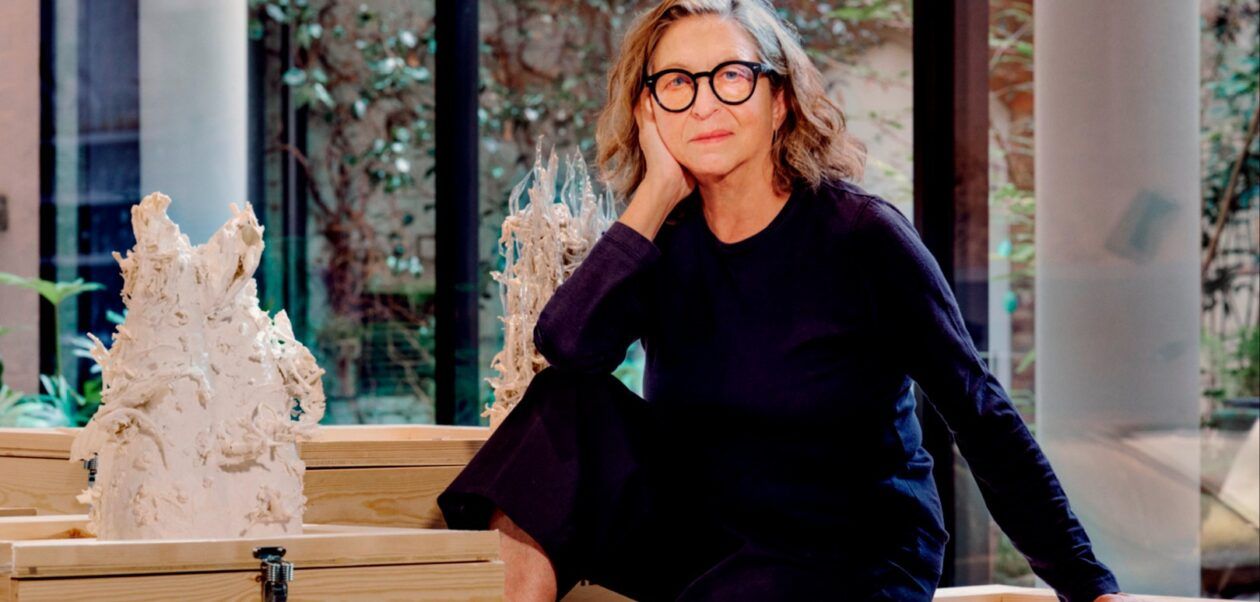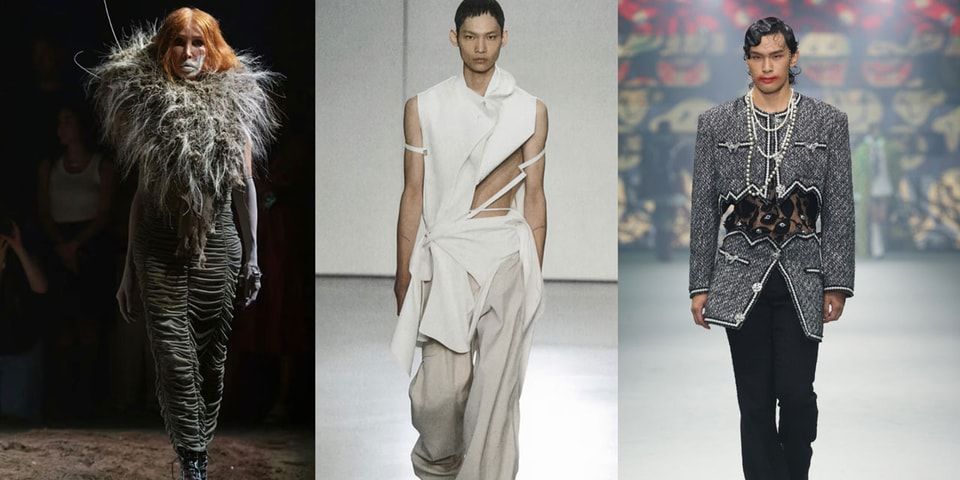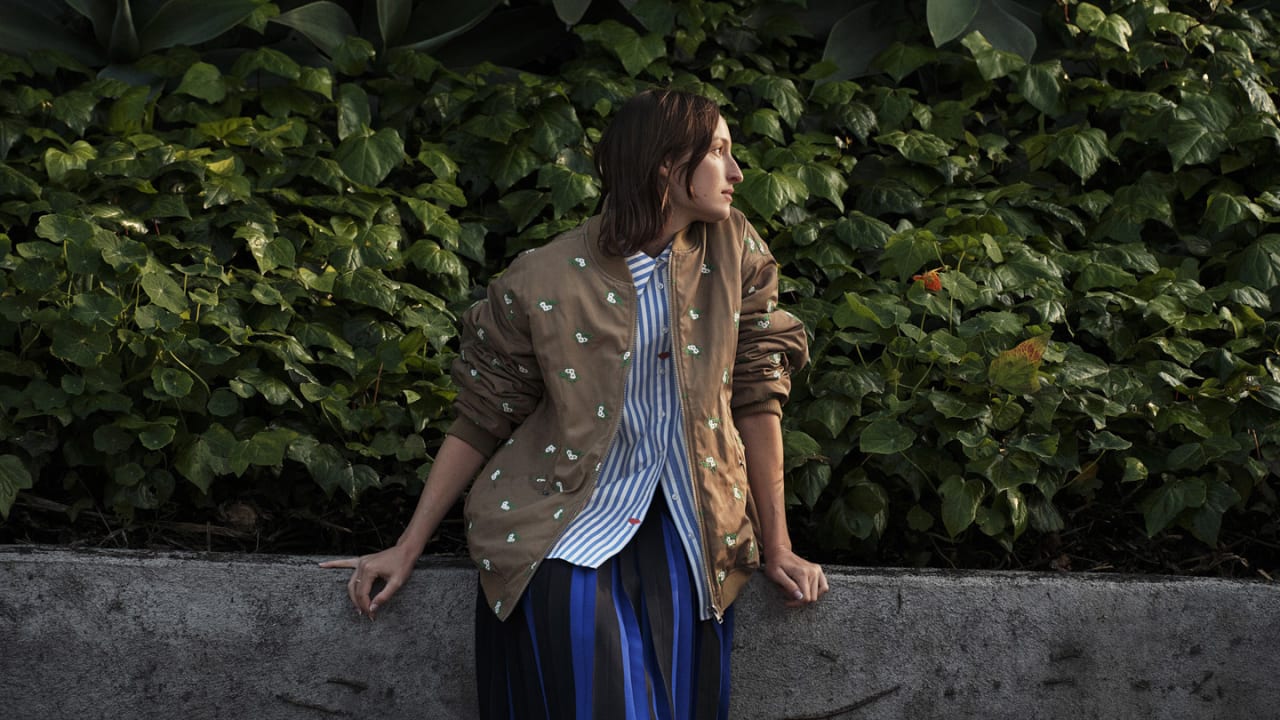“When I think of fashion and what I do now, it’s just another material for producing something beautiful”, says sculptor Lucille Lewin, who founded the fashion label Whistles in 1976.
Lewin is one of a handful of fashion designers — along with Nicole Farhi, Osman Yousefzada and Graeme Black — who have made, if not the leap, then a shimmy across the design spectrum to embrace a second work chapter as an artist.
What they all now enjoy is a freedom from bottom lines or the hamster wheel of producing cruise, pre- and ready-to-wear collections.
What else has their fashion background taught them? Resilience and the ability to keep trucking on. As Lewin has come to understand — with reference to the “kiln gods” who come to destroy and yet, sometimes transform her ceramic work — “failing is also where you find complexity of thought.”
Lucille Lewin, founder, Whistles
“I wondered if I would be good enough, but the elephant in the room was really my age, I was 68 at the time,” Lewin says of being accepted at the Royal College of Art in 2015.
After a stint as creative director at Liberty in the noughties and then recovering from an operation to remove a non-cancerous brain tumour, she dropped a friend off at a ceramics class and was invited to try her hand. She started night classes and a City Lit course before being encouraged by her tutors to apply to the Royal College.
Lewin received a masters in ceramics and glass from the Royal College in 2017. In her final year of study, she was also awarded the Young Masters Maylis grand ceramic prize and has since shown at the V&A, Christie’s and Collect at the Saatchi Gallery.
Lewin’s confections of porcelain recall a Baroque fantasia. “I love things that relate to the natural world but are not of the natural world,” she says, and is inspired by early photographer Karl Blossfeldt and Hieronymus Bosch. Her sculptures are made with fragments that she collects — paper, wood or natural objects — which she joins together and assembles. She uses clay and salts and the process of multiple dippings is a long, arduous one which takes several months.

Her recent exhibition at the Harley Foundation, Second Nature, was a reflection on the human impact on the environment and its possible disastrous consequences spurred by the eccentric fifth Duke of Portland’s construction of complex underground rooms and tunnels under his estate.
What has working in fashion taught her? “Ha, that putting on an art show is so easy. The downside is that my brownie points and network is in fashion. I’m like an emerging artist but with more wrinkles.”
Suzanne Clements, co-founder, Clements Ribeiro

“I think if we were allowed five lives, fashion would be one of them and I’d work myself to death and I would be utterly consumed by 20-hour-long days, but you only get one life. I wanted to find a way to extract myself from something that was no longer about being creative. I thought as [my label] became more successful, it would get easier, yet it actually got harder.
“When I started out, fashion in the early nineties was about a way of being different, being expressive. And then it became really commercial and celebrity-driven. We created a beast, and I became a slave to it.”
In 2019 Clements started a MA in fine art at the City and Guilds London Art School. “I didn’t expect it to be so life-changing: it was entirely my own thing that I didn’t have to share with Inacio [one half of fashion label Clements Ribeiro], or which involved a whole machine, and that was quite freeing. No longer did I have to switch between business and creativity, and I could just stay in a creative headspace.”
Clements held her first show in July. Her paintings, priced from £1,700, are largely autobiographical and centre on a woman’s body as a vehicle to express herself. “I suppose that’s quite similar to fashion, the thinking about proportions, how you stretch and expand them to explore fragility and vulnerability.” Behind the playfulness lies an undercurrent of something darker, unsettling at work.
“Initially, I made a point of separating [fashion and art], eager to break away from fashion. I now feel confident as an artist and no longer feel the need to keep them apart. In fact, I quite like being able to dip between the two.”
Graeme Black, former creative director, Ferragamo

“The thought that the next 20-30 years of my life is going to be dedicated to being an artist is exciting,” says Graeme Black, whose inspiration today comes from wandering the forests near his home in North Yorkshire, where he lives with his interior designer and architect partner Jonathan Reed. Nature, form, colour and texture have always influenced his work, but instead of designing clothes, he paints the bark of trees through different times of the day and seasons.
It is a world away from his 7-year stint in Milan working with Giorgio Armani, a subsequent role as creative director at Salvatore Ferragamo and then heading up his own eponymous label, which was sold at Saks Fifth Avenue, Neiman Marcus and Harvey Nichols.
The catalyst? A quest for more life/work balance after the relentless travelling to China that started in 2012, when he became creative director for the Chinese cashmere label Erdos. “It was a great job and team, but Jonathan and I had recently bought a house in Yorkshire and were figuring out how we could make changes to our life.” The biggest challenge has been a shift in working as part of a team to sitting in a studio alone.
Although Black had a degree from Edinburgh College of Art where drawing skills were deeply rooted, he was frustrated at first by his lack of technical knowledge. “I did a portrait course with an Italian artist in London who taught me how to layer colour, who would tell me that I was just moving paint around; that I needed to observe the nuances of where the light fell. But I’m a great believer in just doing it, and not being frightened.”
Trunk show III will open at Thorns Gallery, North Yorkshire, on November 16
Nicole Farhi, founder, Nicole Farhi

Nicole Farhi, who grew up near the Fondation Maeght in St-Paul-de-Vence, recalls the first time she saw the Alberto Giacometti sculpture titled “Woman with Her Throat Cut”. “I was 14 and it moved me like no painting had ever done before. I knew then that three-dimensional work was what touched me most. But I never for a minute thought I’d be able to do it.”
Farhi attended art school in Paris, where she studied painting, drawing and fashion and was quickly selling sketches to a magazine. By the age of 20 — in the late 1960s — she was making a living from it.
Farhi met the retailer and founder of French Connection, Stephen Marks with whom she had a daughter, then moved to London and worked on French Connection and her eponymous fashion label. In the early 1980s she met a sculptor who introduced her to her first teacher, Jean Gibson.
“I’ve been sculpting for over 35 years, one day a week and all weekend. I would always feel sad on a Monday morning to go back to work and that became more and more the case.”
When her company was sold to Opengate Capital in 2010, her dream to spend more time in her studio became a reality. Although she initially agreed to stay on for two years, she only stayed on for a few months. “I lost my heart, many stores were closed and it was a blow to see everything I’d built disintegrate so rapidly.”
She held her first show at the Bowman Sculpture gallery. Her biggest challenge? She laughs: “For people to forget that I was ever a fashion designer. I wish they’d say, ‘I’ve seen your sculpture, and they are wonderful but, no, they tell me, I still wear your clothes from 20 years ago, or my daughter does’.”
Her work, which starts from around £1,000, has evolved over the past few years: female forms that were figurative at first have become more abstract. She acknowledges that her name helps because people want to see what she gets up to next. “My last fashion show was in September 2012, the next day I was in my studio and I haven’t left since.”
Miscarriages of Justice, curated by Selina Skipworth at Mishcon de Reya, London, opens Spring 2024
Sara Berman, founder, Sara Berman

Three things made the former fashion designer shelve early childhood aspirations to become an artist. The first was being randomly assaulted in the White Cube gallery when she was 18. Secondly that her mother Helene Berman was a successful fashion designer and so fashion was a world she understood. And, thirdly, that “Central Saint Martins was just a lot of fun in the ’90s for a creative. It was less about the business of fashion and more to do with the making. And really, that is what I have always been drawn to.”
Despite setting up her own label in the late ’90s, which was featured in Vogue and won the Marks and Spencer New Generation award three times, by 2014 Berman felt fashion had stopped being about storytelling and had become more about business. “So much changed in those 15 years. I had always been interested in the academics of dress and it had stopped being about that.”

She completed an MFA at Slade UCL, graduating in 2016 to become a visual artist firmly rooted in paint but also working with clothes and textiles. “Really, I left an industry to be industrious. I make all day and I constantly push myself as a maker rather than for any other motivating reason. Not many are able to exist in a vacuum, but I can.”
Berman’s work examines the societal constructs of the female experience, and her figures are often defiant while her gentle, muted aesthetic is fraught with contrapuntal layers. Her work has been shown at Frieze, The Royal Academy of Art Summer Exhibition, Hauser & Wirth, Eye of the Collector and The Armory in New York.
Sara Berman’s No Visible Means of Support, West Palm Beach, October 28-December 2




